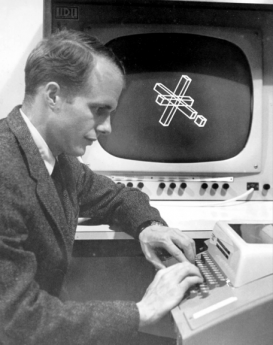In the last 40 years the field of computer science has undergone a dramatic transformation, from an abstract mathematical discipline built on machines used for procedural calculation, to a complex ecosystem of objects fueled in large part by the simulation of material interactions. In short, computing has transformed from a tool into a medium. In the United States this change was brought about largely through the growth of key research fields funded by the Defense Department’s Advanced Research Projects Agency, beginning in the 1960s. Chief among these was the development of tools for the visual simulation of material objects, networks, and systems—that is, the field of computer graphics. While most historical narratives of computer graphics begin with their rise to visibility in popular film and video games during the 1980s and 90s, in fact the technology predates this moment by over 30 years. The very first stored-program computers included simple oscilloscope monitors for data output and display, and technical research into the manipulation of light for two-dimensional image output by computer goes back to at least 1947. Yet it is not until the 1960s that researchers developed and standardized the process by which material objects are digitized, manipulated, and displayed.
This project investigated the early history of computational object simulation and visualization, with a focus on early graphics research at the University of Utah in the 1960s and '70s. In doing so it looked to the longer history of simulation as a cultural technique in the production of scientific knowledge, one often mediated through a variety of technical and cultural forms, from war games and flight simulation to meteorology and martial arts. What is the function of simulation as a method for scientific investigation? How has the visual simulation of data structures transformed scientific knowledge in the twentieth century? How does the material history of graphical simulation structure and limit the forms of knowledge that may be derived from such images? While popular accounts of modern simulation often associate the term with the virtual and the ephemeral, this project looks to ground practices of simulation in the cultural, technical, and social conditions of their production through an investigation of specific research sites like the University of Utah graphics program. In doing so Jacob Gaboury argues for simulation as a material practice found in a wide range of scientific disciplines.

